Related Research Articles
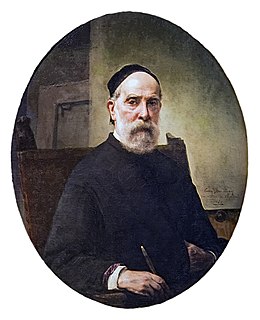
Francesco Hayez was an Italian painter. He is considered one of the leading artists of Romanticism in mid-19th-century Milan, and is renowned for his grand historical paintings, political allegories, and portraits.
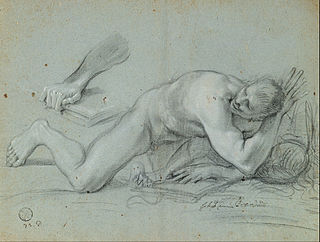
Giovanni Angelo Canini (1609–1666) was an Italian painter and engraver of the Baroque period.

The Archdiocese of Fermo is a Roman Catholic ecclesiastical jurisdiction in northern Italy, with its seat in the city of Fermo, Marche. It was established as the Diocese of Fermo in the 3rd century, and elevated to an archdiocese by Pope Sixtus V on 24 May 1589. The archiepiscopal seat is Fermo Cathedral. The current archbishop is Rocco Pennacchio.
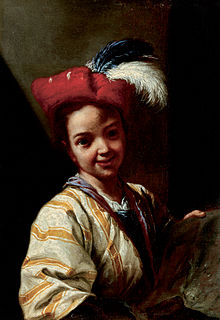
Antonio Amorosi was an Italian painter of the late-Baroque, active in Ascoli Piceno and Rome. Amorosi was born in Comunanza, then part of the Papal States. In 1668, he moved to Rome where he was trained by Giuseppe Ghezzi. He painted genre scenes similar to those of the Bamboccianti.
Events from the year 1704 in art.

Giuseppe Ghezzi was an Italian painter of the Baroque period, active mainly in Rome.
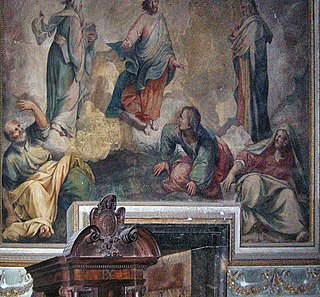
Durante Alberti was an Italian painter of the late-Renaissance period.

Cosimo Morelli was an Italian architect, active throughout the Papal States in a Neoclassic style.

Filippo Abbiati (1640–1715) was an Italian painter of the early-Baroque period, active in Lombardy and Turin, together with Andrea Lanzani and Stefano Maria Legnani, he was a prominent mannerist painters from the School of Lombardy. Born in Milan, he was a pupil of the painter Antonio Busca. Alessandro Magnasco was one of his pupils along with Pietro Maggi and Giuseppe Rivola. Ticozzi claims he trained, along with Federigo Bianchi, with Carlo Francesco Nuvolone. Along with Bianchi, he painted the cupola of Sant'Alessandro Martire in Milan. Abbiati also painted a St. John preaching in the Wilderness for a church in Saronno.
Natale Ricci (1677–1754) was an Italian painter, He was a pupil of Carlo Maratti, and a native of Fermo. He practised in Italy in the 18th century. He is part of the family of painters that includes Ubaldo (1669–1731), Filippo (1715–1793), and Alessandro Ricci (1750–1829).

Giovanni Enrico Vaymer was an Italian painter of the Baroque period.
Marchetti is an Italian surname. Notable people with the surname include:

Teodorico Pedrini, C.M., also known by his Chinese name De Lige, was an Italian Vincentian priest, musician and composer, but mainly missionary for 36 years at the Imperial Court of China.
Vincenzo Pagani was an Italian painter of the Renaissance period.
Francesco Foschi was an Italian painter best known for painting winter landscapes.
Pio Panfili was an Italian painter and engraver.
Gaetano or Cayetano Palmaroli was an Italian painter, but mostly remembered as a lithographer.

Giordano Macellari is an Italian painter.
Lorenzo Foschi (18th-century) was an Italian painter.
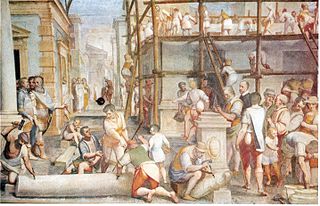
Republic of Genoa was rich oligarchic republic, where the authorities were powerful bankers. In the Renaissance, Genoa was not developed into significant arts center, as it was for Florence, Ferrara, Rome, Rimini, and Venice. But in the 17th century Genoa had an original school of painting, called Genoese School, which was to develop Flemish contacts. The best painter was Bernardo Strozzi, called il Cappuccino, of great importance also for Venice. Giovanni Castiglione, called Il Grecchetto, took up a genre already made famous by Sinibaldo Scorza with paintings of animals and still lifes under Flemish and Venetian influence. Domenico Fiasella and Gioacchino Assereto joined the Caravaggesque followers, while Valerio Castello was more eclectic. The decorators Domenico Piola and Gregorio de Ferrari worked in the churches and palaces of Genoa.
References
- Bryan, Michael (1889). Walter Armstrong; Robert Edmund Graves (eds.). Dictionary of Painters and Engravers, Biographical and Critical. Vol. II L-Z. London: George Bell and Sons. p. 372.
- ↑ Guida storica e artistica della città di Fermo, by Dr Vincenzo Curi, Tipografia Bacher, Fermo (1864), page 96.
- ↑ Filippo e Alessandro Ricci: pittori nella Marca del Settecento, by Stefano Papetti, Giovanni Ciarrocchi, Massimo Papetti; editor F. Motta, 2009.
- ↑ Curi, page 96.